

Reprinted from NewfTide Vol 10, Number 2, Summer 1979
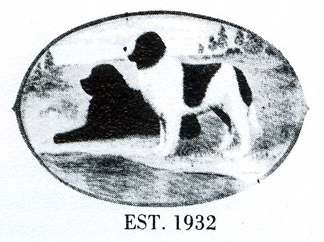
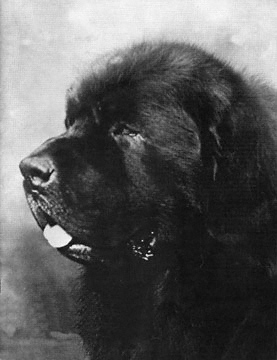 Am. and Can. Ch. Dryad's Strong Sea Pirate, strong in individual achievement and contribution to Seaward Kennels, is featured on our front cover. He is named after the original Ch. Oquaga's Sea Pirate, one of the outstanding blacks at Seaward and basis for their present day Landseers.
Am. and Can. Ch. Dryad's Strong Sea Pirate, strong in individual achievement and contribution to Seaward Kennels, is featured on our front cover. He is named after the original Ch. Oquaga's Sea Pirate, one of the outstanding blacks at Seaward and basis for their present day Landseers.
The history of Seaward Kennels, Reg. establishes the kennel as one of the oldest breeders of Newfs, founded in 1932 as CAMAYER by Elinor Ayers Jameson and John Cameron. After the death of the founders, the kennel program was taken over by Mrs. Jameson's daughter, Elinor C. Ayers ("Nell"), a breeder of Airedales, Newfs and West Highland White Terriers.
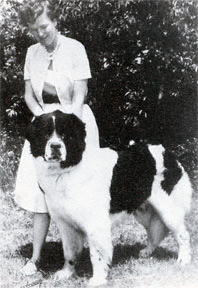 The breeding stock was moved for a number of years to the kennel facilities of their handlers, Betty and Ned Cummings of Wynfomeer. In the early summer of 1975 all the stock of Seaward was moved into the newly built kennel in North Rupert, Vermont, managed by Norman A. Frazier.
The breeding stock was moved for a number of years to the kennel facilities of their handlers, Betty and Ned Cummings of Wynfomeer. In the early summer of 1975 all the stock of Seaward was moved into the newly built kennel in North Rupert, Vermont, managed by Norman A. Frazier.
Although Seaward specializes in primarily breeding the Landseer marked Newfoundland, they have always owned and bred black Newfs and have many champions, both Landseer and black, to their credit.
The following is an interview with Nell Ayers, owner of Seaward Kennels and President of the Newfoundland Club of America. Seaward Kennels is a well-established kennel located in North Rupert, Vermont. In her interview, Ms. Ayers accounts the past, present and future directions of Seaward and its Landseers. Further, she lends us some insights to our breed.
Most of our readers have read the Gaines article on kennel structure. I think they would like to know more about the formation of the kennel itself. In addition to this, what is the history behind the development of Seaward?
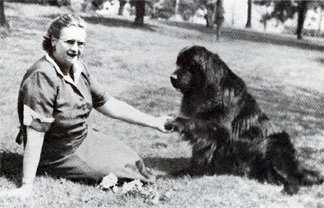 My mother, back in the late '20's, got her first Newfoundland which was black. Like many people she had never seen a white and black except for in a picture. The first one she saw was around 1931 at Westminster; it was a Waseeka dog and also Jack Cameron had one. Right off she began chatting with him and before she knew it, she bought her first landseer from Jack. The following year, she and Jack went into business and coined Camayer for the Ayers and Camerons. At that time, landseers were really depleted due to WWI. It was their feeling that by trying to breed Canadian dogs and import some of the English dogs, they would start to perpetuate the landseer again. Therefore, Jack and mother concentrated all of their efforts on such breeding all through the '30's and '40's. Around the early '40's, my mother became interested in breeding blacks to landseers to strengthen the landseer lines. Around 1945, Jack gave my mother a black, Sea Pirate (Pat), who became a top winner in the '40's'and '50's, and was used with all the landseers in breeding.
My mother, back in the late '20's, got her first Newfoundland which was black. Like many people she had never seen a white and black except for in a picture. The first one she saw was around 1931 at Westminster; it was a Waseeka dog and also Jack Cameron had one. Right off she began chatting with him and before she knew it, she bought her first landseer from Jack. The following year, she and Jack went into business and coined Camayer for the Ayers and Camerons. At that time, landseers were really depleted due to WWI. It was their feeling that by trying to breed Canadian dogs and import some of the English dogs, they would start to perpetuate the landseer again. Therefore, Jack and mother concentrated all of their efforts on such breeding all through the '30's and '40's. Around the early '40's, my mother became interested in breeding blacks to landseers to strengthen the landseer lines. Around 1945, Jack gave my mother a black, Sea Pirate (Pat), who became a top winner in the '40's'and '50's, and was used with all the landseers in breeding.
Was the picture taken around here?
 No that was where we lived in Greenwich, N.Y. The original kennel was in Pleasantville, N.Y. and later moved to Ossining, N.Y. Mother decided she wanted to go into the interbreeding of landseers and blacks more; that's when she took the name of Seaward, in 1944. The name was taken from my grandmother's home in long Island. Mother and Jack still continued to breed landseers, but she really built her own kennel. By the time Jack died toward the late '50's, she was already established as Seaward.
No that was where we lived in Greenwich, N.Y. The original kennel was in Pleasantville, N.Y. and later moved to Ossining, N.Y. Mother decided she wanted to go into the interbreeding of landseers and blacks more; that's when she took the name of Seaward, in 1944. The name was taken from my grandmother's home in long Island. Mother and Jack still continued to breed landseers, but she really built her own kennel. By the time Jack died toward the late '50's, she was already established as Seaward.
When did you get totally involved with the dogs?
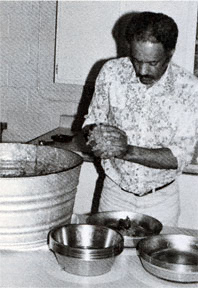 As a child I was always involved and the dogs were always around me. I was born at home with an Airedale and a Newf. I became a breeder of Afghans when I was about 11. In the late '30's my mother bought me an Afghan for my birthday, which I showed and bred. I owned Newfs, but under mother's control. Then, I became a breeder of Airedales and had my own champion bitch out of mother's breeding; Seaward always did well with their Airedales. Tom Gately, a professional handler and now judge, showed the Airedales as well as the Newfs. Later, I went out of breeding Airedales, and into breeding Westies.
As a child I was always involved and the dogs were always around me. I was born at home with an Airedale and a Newf. I became a breeder of Afghans when I was about 11. In the late '30's my mother bought me an Afghan for my birthday, which I showed and bred. I owned Newfs, but under mother's control. Then, I became a breeder of Airedales and had my own champion bitch out of mother's breeding; Seaward always did well with their Airedales. Tom Gately, a professional handler and now judge, showed the Airedales as well as the Newfs. Later, I went out of breeding Airedales, and into breeding Westies.
When your mother first started with Newfs, how was the kennel laid out?
In those days, we just had a big paddock; all of our dogs were together.
That was a lot of dogs. Your mother must have had a lot of help.
No, Jack and his wife did most of the work. They would also have a few kids come in after school.
What problems did your mother encounter during WWII?
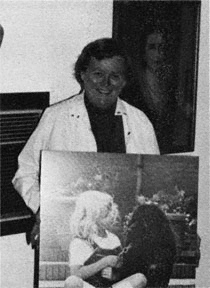 It was very, very difficult with the food. At that time, some of the grained food was beginning to become available. All of us in the family had two meatless days so our meat coupons could go for the dogs; they were fed a lot of chicken. In fact, Jack raised chickens during the war for the dogs; they also got a lot of rice. It was a real entrenchment because I guess they must have had around 100 Newfoundlands when the war started. It meant backing off and as the dogs died along the way we just didn't replace them.
It was very, very difficult with the food. At that time, some of the grained food was beginning to become available. All of us in the family had two meatless days so our meat coupons could go for the dogs; they were fed a lot of chicken. In fact, Jack raised chickens during the war for the dogs; they also got a lot of rice. It was a real entrenchment because I guess they must have had around 100 Newfoundlands when the war started. It meant backing off and as the dogs died along the way we just didn't replace them.
Where did your mother have the litters?
They were born at Jack's house, usually off to the side of the kitchen, and were very much a part of the family situation.
They were really socialized then?
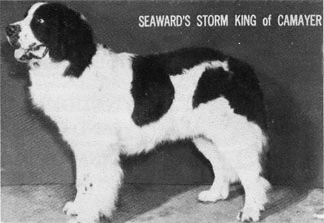 Yes, very much. When we built the other kennel in Greenwich, there was an old stable, which we converted into our kennel. Again, we used paddocking. It wasn't until I built the kennel here that we went to more singular type of kennel runs. This summer we are going back. We are going to build paddocks in the back again so that we will at least get our puppies out in paddocking.
Yes, very much. When we built the other kennel in Greenwich, there was an old stable, which we converted into our kennel. Again, we used paddocking. It wasn't until I built the kennel here that we went to more singular type of kennel runs. This summer we are going back. We are going to build paddocks in the back again so that we will at least get our puppies out in paddocking.
We are putting in three paddocks first, one 50 by 100 feet and two 50 by 50 feet in the woods so they will have rocks and trees to stumble and fumble around with. Certainly it will be a great advantage for the pups where they can get good footing. We don't use concrete in the runs. The pups are really handicapped, especially those born in the winter because they get out and what is it but ice! Basically, they are on a hard surface in the wintertime, which I don't think is good. Whether they are in a home or not, I think the pups need the earth.
What would you change in your kennel now?
 I wish I had been able to have larger spacing for paddocking in the winter. Also, one nagging problem has been the guillotine doors. They should in practice work very well, but they don't.
I wish I had been able to have larger spacing for paddocking in the winter. Also, one nagging problem has been the guillotine doors. They should in practice work very well, but they don't.
Where did you go to get your ideas for structure of the kennel?
Most of this was my own design based past experience. I went to the Architecture Institute of America in N.Y. to find out if there is such a creature that designed kennels; of course, there was not. I finally fell upon a young architect in Manchester. He brought me preliminary drawings, and after several talks I felt we could work together.
What provisions have been made for he cold winter months?
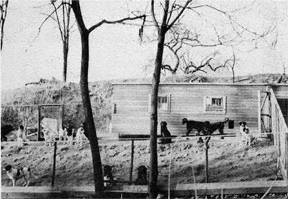 The area we heat is primarily the core of the building, i.e. the grooming and boarding sections. The cement slabs, which the dogs are on most of the time, are not really heated except when the temperature drops to 20 below. Then we kick up the heat to 50 degrees. Usually, the temperature of the slabs is around 45 degrees.
The area we heat is primarily the core of the building, i.e. the grooming and boarding sections. The cement slabs, which the dogs are on most of the time, are not really heated except when the temperature drops to 20 below. Then we kick up the heat to 50 degrees. Usually, the temperature of the slabs is around 45 degrees.
What do you feed your dogs?
Kennel biscuit is what we have used for over 20 years. We are now using natural feeding. We give a lot of B Complex, E and C vitamins, herbs, zinc, and brewer's yeast. Some of the dogs get raw beef, about 1/2 pound, which is cut into two-inch chunks packed into 25 pound bags and frozen.
What kind of genetic problems did your mother run into during the '30's?
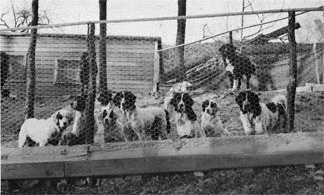 The common problems we have with landseers, which you still sometimes see today but far less, is that the landseer used to be a dog, which had a great deal more of a splayed foot; not what we call a tight capped foot. This has been a continual problem for any person that has been involved with the breeding of landseers over the years. We have now gotten to the point where I believe that probably our dogs are as tightly footed as any. We do have a couple occasionally that are a little splayed, but not to the point where years ago you used to see the webbing between the feet.
The common problems we have with landseers, which you still sometimes see today but far less, is that the landseer used to be a dog, which had a great deal more of a splayed foot; not what we call a tight capped foot. This has been a continual problem for any person that has been involved with the breeding of landseers over the years. We have now gotten to the point where I believe that probably our dogs are as tightly footed as any. We do have a couple occasionally that are a little splayed, but not to the point where years ago you used to see the webbing between the feet.
So, in other words, it's not just what they are running on?
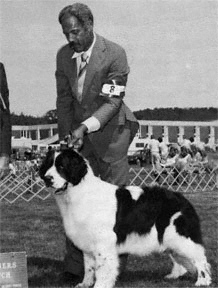 No, if anything, gravel tightens the foot. I have one dog that is a very large dog whose feet at three months of age showed signs of separation. He doesn't have a splayed foot, but it's not really a nice foot either. I think he was too darn big; too big, too heavy!
No, if anything, gravel tightens the foot. I have one dog that is a very large dog whose feet at three months of age showed signs of separation. He doesn't have a splayed foot, but it's not really a nice foot either. I think he was too darn big; too big, too heavy!
Another problem we've had, and here I'm not too sure that this may not go back to the days when St. Bernards were used with Newfs in breeding, is a haw in the eye. It is a known fact that Saints and Newfs were bred at the hospice back in 1850 to strengthen the Saint Bernard when they were beginning to go downhill. I can't help but believe that some of these crosses eventually sort of got back into the lines. A reputable breeder in England told me several years ago that they know of people who breed Saints into their Newfs and they knew of it within the last 50 years.
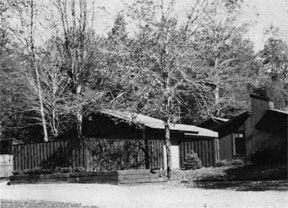 So, if this is true, this may account for the haw in the eye, which we see. I think that Newfs generally did not have this draggy haw; this is evident in the early paintings. If you look at these paintings, granted you have the artist's interpretation; however, too many portray the dog looking the same-a longer muzzle and higher ear set. These are the dogs you see in Europe. They have a higher ear set than we have here and not with an exaggerated stop. That also has been a problem with landseers, and a little harder to lick.I have had some litters where the eye is lovely and tight, and others where the dogs look like a bunch of drunks after a party the night before! I do think that this is something carried down in the lines
So, if this is true, this may account for the haw in the eye, which we see. I think that Newfs generally did not have this draggy haw; this is evident in the early paintings. If you look at these paintings, granted you have the artist's interpretation; however, too many portray the dog looking the same-a longer muzzle and higher ear set. These are the dogs you see in Europe. They have a higher ear set than we have here and not with an exaggerated stop. That also has been a problem with landseers, and a little harder to lick.I have had some litters where the eye is lovely and tight, and others where the dogs look like a bunch of drunks after a party the night before! I do think that this is something carried down in the lines
As you look at the pictures, you'll also see a dog that has a great deal of leg under it; this is something that is traditionally landseer. They have always been a taller dog than the black. The black used to be a lot taller than it is now; they were not as heavy a dog as they are now either.
Don't you find that the Landseer, the black and white combination, gives you an illusion of seeing a taller dog?
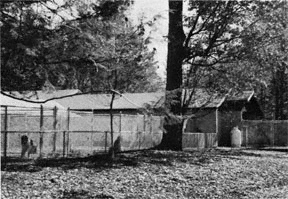 Let me make one correction, for what it's worth, the landseer is a white dog with black, not a black dog with white. When one refers to a mismark, it turns out he/she is actually talking about a mismarked black, which may have four white legs, white on the chest and white on the underbelly; that's a black dog with white and not a white dog with black. Color is a tremendous illusionary factor
Let me make one correction, for what it's worth, the landseer is a white dog with black, not a black dog with white. When one refers to a mismark, it turns out he/she is actually talking about a mismarked black, which may have four white legs, white on the chest and white on the underbelly; that's a black dog with white and not a white dog with black. Color is a tremendous illusionary factor
Thelma Brown has written a very good book on color and its illusions in the ring. In the case of the dog who has one complete black and one complete white leg, it appears as if two dogs are coming at you. Also, there's no question that the blaze narrows the head.
What other genetic problems have you encountered?
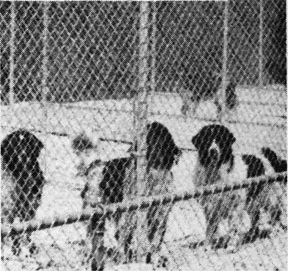 We have felt that landseers have been sounder than blacks, accounting for the lack of excessive HD. However, in 1945 when we did begin x-raying our dogs, we did discover some HD. Many dogs were put down because they were dysplastic and shouldn't be used for breeding. It's funny how the circle has rounded itself over the years; it is thought now that like Saints, Newfs are a luxoid breed-loose, amble and roll. The dogs put down years ago now would be considered normal. Every one of our dogs is x-rayed, although we don't use OFA.
We have felt that landseers have been sounder than blacks, accounting for the lack of excessive HD. However, in 1945 when we did begin x-raying our dogs, we did discover some HD. Many dogs were put down because they were dysplastic and shouldn't be used for breeding. It's funny how the circle has rounded itself over the years; it is thought now that like Saints, Newfs are a luxoid breed-loose, amble and roll. The dogs put down years ago now would be considered normal. Every one of our dogs is x-rayed, although we don't use OFA.
I think x-ray tells you something else about a piece of a picture of your whole Newf. I do not feel the dog has to be absolutely perfect in hip. At one point, we had four generations of cleared hips and then it came up in the fifth generation of pups. I don't know the answer, but feel that x-raying is one way of utilizing information.
The landseer, until recently, has not had as heavy a bone as the average black. I won't say they are fine boned, but landseers have not had some of the massive bone the blacks have. This goes along with their general structure. Over 100 years ago they were a lighter animal; they probably were more attuned to the breed of 100 years ago than the black is.
If you breed for heavier bone, won't that slow your Landseer down?
Yes, it could. Unfortunately, you are forced into this because you want to have something that is similar to what is winning in the show ring. Therefore, you try to get your landseer more in that image. I don't know if at this stage whether it's done good things or bad.
Do you think the Landseer should be judged separately?
No, I don't. To me the landseer has more similarities to blacks than dissimilarities. Until recently, they were judged separately in Europe; England is the only remaining country where they are still judged separately. Separate judging would insist that landseers can only be bred to other landseers. What you're going to do here is drop the bloodlines.
Do you see the trend of the Landseer having a hard way to go in the show ring changing?
Yes, back in the 1800's, the early standard, there was a battle between black breeders and landseer breeders in England, For a period of time the landseer was far more popular than the black. The island Newfoundland was literally raped of all the, landseers. They were shipped over England, particularly during the time that Edwin landseer was painting. I think, frankly that there was just plain jealousy here. The negative attitude was perpetuated by black breeders and after all, judges come from a pool of just plain people. Also, until the' there was not a consistent group of l; seers being shown. It wasn't until Montana Mustang Arno came along that people were taking notice. I think Pied Piper did great things for the landseer in Canada as well as down here. More and more landseers will be winning and having their rightful place sun, so to speak. The owners of Seaward are tenacious. We must judge a Newf by it and structure and secondly, if you have to look at color, then look at color; but it is the overall animal that must be judged.
Who handles your dogs?
Betty Cummings started handling in 1958 and she has handled for us ever since We have had other handlers over the years that have also handled dogs, but she is the one who got the first championships on the landseers. I suppose she handled more landseers to their championship than probably any other handler in this country.
She is a pro and knows how to use her own leverage in this sort of thing. She and her husband are accomplished breeders. At the time, I was not sure at all what I was going to do; I was in education and in Montclair, N.J.
Were you a teacher?
Yes, for 21 years.
What did you teach?
I was a Phys. Ed. teacher at first, then I was in Guidance. The last school system I was with was Montclair High School, and I have several graduate degrees and lots of activity that I was involved with in education.
So, I told Betty to go ahead and keep the champion bitches because I felt she had the facilities for the breeding.
Where was this accomplished?
In Connecticut. We moved there in 1953 or '54. At the time of mother's death she had about 15 to 20 Newfs. The bitches were signed over to Betty. At that point, that's when Betty and I went into breeding the landseers.
At that time you were still teaching?
Yes, I was still teaching and I was involved with trying to sell off the dogs. I did retain several dogs, which I kept at Betty's kennels.
As I reached a stage in my career, education work, I had to decide whether I was going to remain in the school system or whether I wanted to really become much more involved with the dogs than I had. I decided to take a year's leave of absence from school just to sort of see if I really wanted to make it a year-around residence. Of course after six months I knew I would never go back to education and the rat race in the schools. So, having made that decision, then I had to decide what I was going to do with the dogs. While Betty had loaned me the facilities, it was also an expense to be paying someone else to take care of the dogs. And from here it was about a two and one-half hour drive. Now I was down there several times a month and usually at all points of whelping and this sort of thing. We got along very well and we are personal friends as well as professionally associated with each other; my toothbrush is still there I Eventually I wanted to have the animals under my own supervision, and so I began thinking about where I could buy land where I could put a kennel. Where I live in Manchester it is restricted and so I knew I wasn't going to be able to put it on my property. For about a year I had quite a search, with real estate people in the area looking around properties. I fell across this in the Spring of '74 and I decided that all things equal, this would suit my needs very well. It was close enough so I could get to it and was isolated enough that it really would not be disturbing other people. There was enough land with the property that gave me a little protection; I had to get a local permit to build and operate a kennel and also pass the very strict Vermont Environmental 250 Act.
What year was this?
In 1974.
So Betty had the kennels until this time?
Yes, I got the property and then it was the process of building.
From start to finish, how long did it take?
The construction began at the end of October or November of '74 and we moved our first dogs in on July 4th weekend of '75; the kennels were still not completed at the time. We built all during the winter, and one of the biggest problems was the dog doors we spoke of earlier .
Who did you have managing the kennel at first?
In those days I had a young man from Ohio. He remained with us until February, a year ago. At that time Norman Fraiser came as manager of the kennels. At the present time I also have George and Linda Johnson. later this summer, Kathy Wasserman is coming back to work with us. She came last summer. She is a junior handler. She will be graduating in June from high school, and she wants more experience so she will be showing our dogs this summer, too.
How many shows do you cover in a year?
I made a record one year and I think we went to about 90 shows, and last year it was 105; at least twice a month and also weekends and sometimes more. We then slow down like everyone does in December and January when there are usually not many shows. We go to Westminster and pick up after March again.
How far do you go?
In general we are in the northeast, mid-Atlantic states and Ohio. We do go in the circuits down south.
You have quite a beautiful gallery here. Did your mother collect a lot of that?
Yes, my mother collected most of them and quite a few were originally used in the NCA book. Gradually, I have added over the years; friends have given me pictures.
Random Thoughts from Nell Ayers
I'm in Newfoundlands, and my philosophy is that if I can help anyone or make it easier for anyone I am willing to do it.
I am sort of a shy person, too, believe it or not. I think most people don't have bravado all the time. I am sometimes reluctant to go up to a total stranger myself, but I am shocked when people say, " don't dare come up and talk with you.'
Basically I think I am fairly friendly. I think that people get together and share and talk, and this is a good thing about having the National Specialties where you can learn about some of the problems that other people are having. I am not threatened about other people having landseers at all, and the more people that I can get interested in breeding the landseer and showing the landseer it's going to help everyone.
The more landseers that win makes it that much more easy for my dogs when they come up. But these are the things that we have to encourage the young people in and the serious breeder, particularly, because unfortunately, as you look back there are very few people who have been in Newfoundlands for 20 years or more. Many become instant experts after the second year and know it all. Then three years later drop out of it and do little to contribute to the dog.
I think that Judi Adler's puppy book is really an excellent book. It discusses many aspects of the training of the dog. I think breeders learn and can share information with each other, and this is important to have happen. Our Newf Tide is one way of doing it, and another is in direct conversation with people.
I would like to see our specialties have some mini seminars-this sort of thing. A couple of half-hour sessions, people describing certain aspects of working with animals and how they feel about these things."